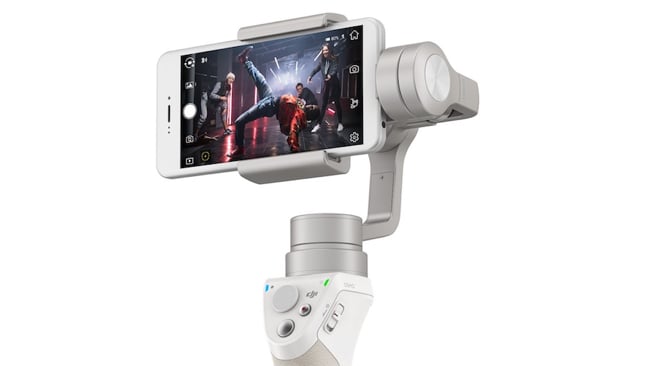
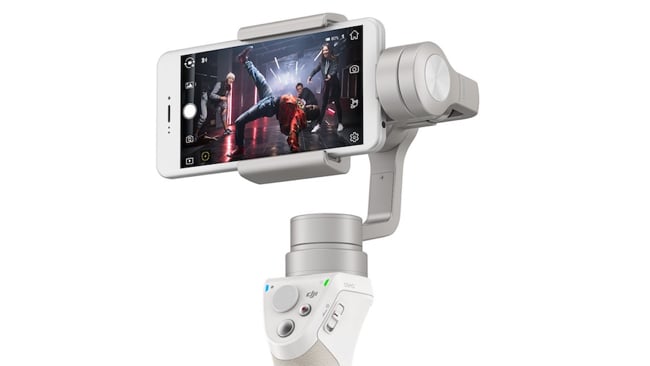 Well balanced: The silver version of the $299 DJI Osmo
Well balanced: The silver version of the $299 DJI Osmo
RedShark Review: The DJI Osmo Mobile is capable of turning your smartphone into a true run-and-gun or B-cam option, which is an impressive feat for a $299 piece of hardware.
Wow, it has come to this. I have a confession to make.
I created a video on my cellphone and I'm kinda excited about the quality… there I've said it. You might be saying, "Really, Kevin, reaaaaaally…a cellphone?!" but I am seriously excited about my new gear purchase, the DJI Osmo Mobile ($299). And you might be too if you get your hands on one.
There are so many gimbals on the market that it can make your head spin. With so many options, you have to sift through the pros and cons to figure out exactly what you need. I have been a DJI user since the early days of the S800 and, while I am brand agnostic, DJI does have a tendency to get things right. I perform a lot of run and gun operations in my line of work and I like to travel and capture video in my free time. The thought of having smooth video without having my professional camera rig with me at all times is sort of a dream. I think to some degree that dream has become a reality with the Osmo Mobile.
"But it's a cellphone."
This is an argument I hear a lot, but lets not forget another saying, "the best camera is the one you have on you." I have the Samsung Galaxy Note 3; it's practically a dinosaur since we are now on the 7th iteration. Conversely, the Osmo Mobile has breathed a new life into its viability. Through the art of motion, it appears to be a nice option on-the-go. To better understand the Osmo Mobile and everything you can get it of it, however, let's take a look at what it offers.
Form and Function
The DJI Osmo Mobile sports a 3-axis gimbal stabilizer with a cradle that can support phones measuring up to 84mm wide and 8.4mm thick (iPhone 6s Plus or equivalent). It is powered with a small 980 mAh smart lipo battery and is charged through a 3.5mm jack on the front of the handle (cable supplied). There is a joystick that can articulate the gimbal head and two buttons, one to trigger photos and another to trigger video. Lastly, there is a third trigger button where you place your index finger in the front of the stick to add a locked position functionality or return to center by double tapping.
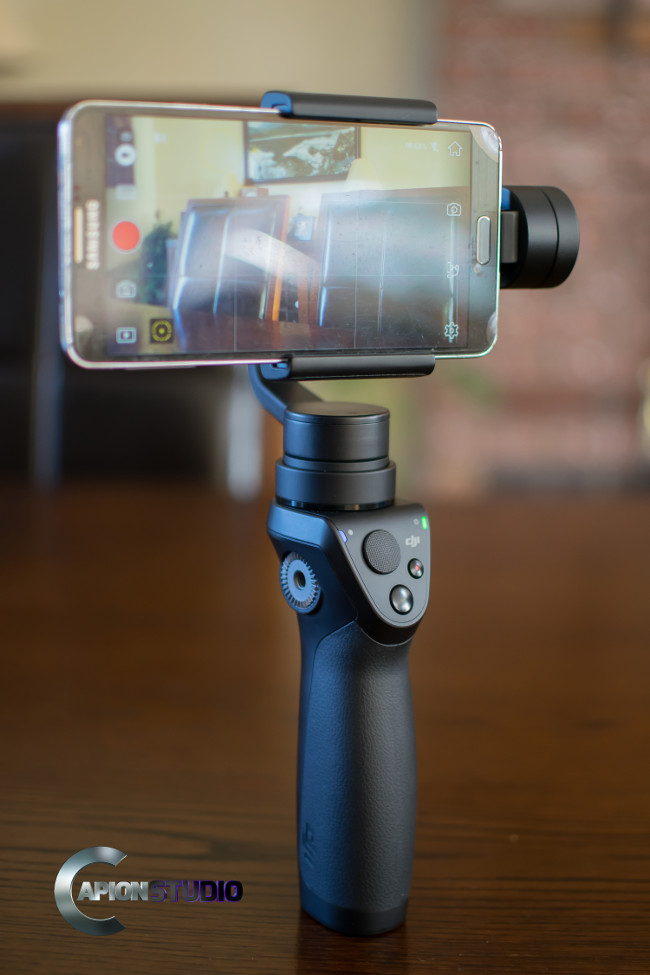
The Osmo Mobile is rather lightweight, weighing 201g with the battery installed, fitting neatly into a supplied zip up pouch. If you would like to add accessories to your gimbal, there is a rosette on the left of the stick to attach a variety of them, such as an independent sound recorder, or to lock it down to a tripod. The battery is a treat; it lasted me a solid two hours without noticing any significant loss or need of swapping. I will have to push this to its limit and see how far I can run it until it depletes.
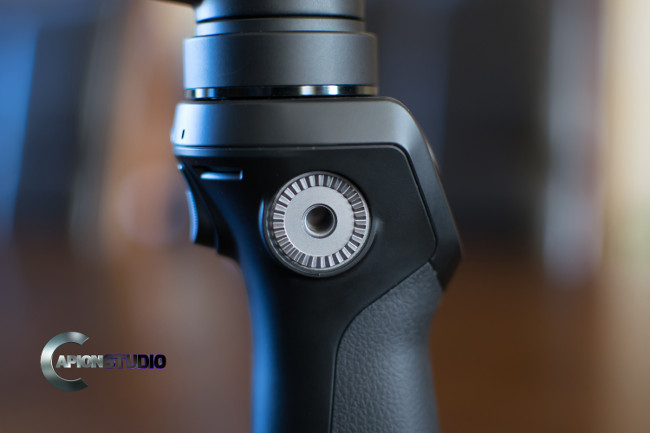 DJI Osmo Mobile Rozette
DJI Osmo Mobile Rozette
For me, the biggest selling point was the Osmo Mobile's functionality. Sure, a lot of gimbals have similar features, like flashlight mode and spot lock, but DJI has done something different with its gimbal: the DJI Go App. The Osmo Mobile has its own application that will pair and sync with your phone via Bluetooth. That means no more pesky wifi scans, setups and passcodes. This a true plug-and-play scenario. Simply turn on Bluetooth on your phone, open the app, press the 'connect to camera' button, and away you go!
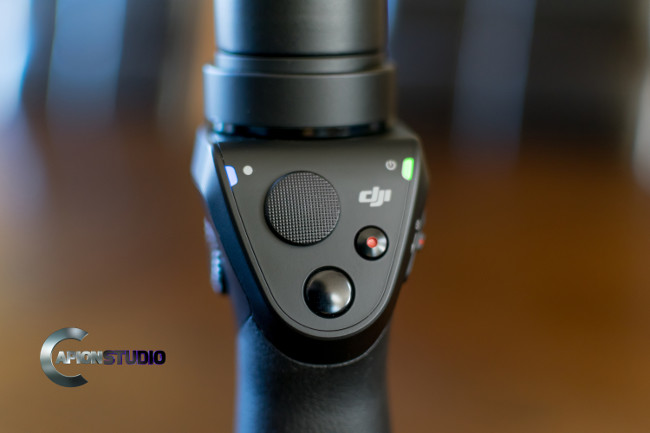 DJI Osmo Mobile Triggers
DJI Osmo Mobile Triggers
What does the app do? For starters, you can auto balance your gimbal, manually adjust your horizon and even adjust the speed in which the gimbal responds. In addition to these features, you can trigger video and photo capture in the DJI Go app (only) via the physical buttons on the Osmo. This means you do not need to touch your screen in order to capture your content. You can, of course, change all the features you'd presumably be able to change through your camera settings, such as the basics of resolution, white balance and flash.
The app also has shooting modes to enable single photo, panoramic, long exposure and even motion control time lapse. Active track is pretty spectacular; draw a box around your subject and the software will move the gimbal, keeping the subject in frame at all times. Think of it sort of like a camera machine vision. Pair this with the live broadcasting feature and you have your very own cameraman for your Internet shows! I especially enjoy the motion control time-lapse, as this was a big selling point for me. It's a rather an intuitive affair. You enter the mode through the app, position your gimbal to where you'd like it to start, use the joystick to position an end point and set the intervals you'd like to create for a capture. This enables you to create multi-point movements with organic motion. The gimbal head moves from point-to-point ever so slightly, snapping photos over your set interval as it moves to its next position.
Potential Pitfalls
I should note there are a few caveats to the level of the app functionality and results may vary. As I mentioned before, I have a Samsung Note 3. Based on my own experience and some additional research, the android app does not have the functionality shared by the iOS counterpart. For instance, the DJI GO app does not support 4K video capture in the menu selection, yet my phone is fully capable of capturing at that resolution. I have done some reading and this might be particular to my phone because newer Samsung users (Galaxy S7) have claimed that the 4K option is present. Whatever the case may be, you might opt to use a third party app for actual video capture, such as Filmic Pro or Cinema FV-5. This will enable you to set your codec, bit rate, exposure lock, focus lock, etc., to a higher degree than running in auto mode through DJI Go.
Another thing that I cringed at is that, while the motion time lapse is absolutely amazing, the time lapse is compressed to a (1080p) video, instead of saving the individual stills. I have yet to discover a work around, but I will continue to dig and even try to request that the still photos are dumped to an alternate folder without video compression. Truth be told, I believe the app is really optimized for iPhones, but some of the features are useful enough to overlook its shortcomings. At the end of the day, so long as I have smooth footage and a way to trigger my video without tapping the screen, I can manage. Now, let's just hope that they unlock 4K on some of the overlooked Samsung models!
Results and Conclusions
I had the opportunity to venture up to Lincoln New Hampshire and try out the DJI Osmo Mobile. I wanted to create an experiential video that captured the magic of the Ice Castles and surrounding areas to convey a winter wonderland. With the Osmo in hand, I used the stock camera and set it to 4K capture. The experience shooting with the unit was awesome. Sure, there is some rigidity and foot steps to my movements, similar to what you might find with any pistol grip-style gimbal. Some of the surfaces I was walking on were slick or uneven. I suspect, with a little more practice, I should be able to eliminate a lot of the jerking action.
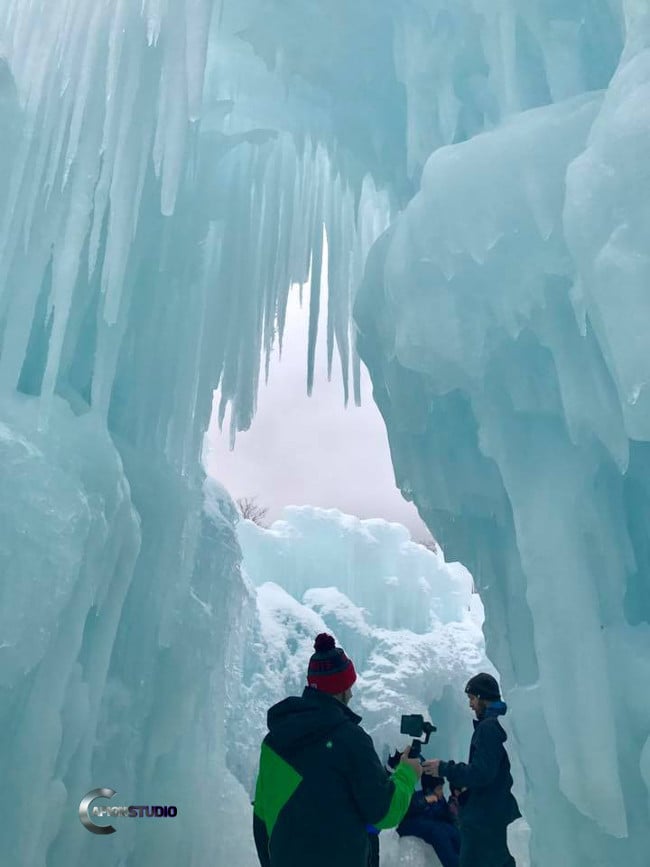
When I got back into the editing room, to my surprise, the footage looked incredible on my monitors. It took a bit of finesse to get my colors where I wanted them, but with some good music and a strong hand in editing, I can say I am pretty happy with the results. For the sake of testing and transparency, I did not apply any post stabilization to these shots, so what you see is all mechanical stabilization. I believe, with warp stabilization on top of this, the footage could look buttery smooth and perhaps even eliminate some of the footsteps. I do not believe this is a prerequisite, however, to attaining smooth footage, but rather the icing on top.
What is the DJI Osmo Mobile good for? Well, in my opinion, it is a powerful gimbal for run-and-gun shooters traveling light or the active VLogger. I also believe it to be a great B-Camera solution when being discrete is of the utmost concern. I cannot tell you how many places I have been to internationally where I have been turned away because my gear looks "too professional." I might have to ditch my Ronin / tripod / monopod or roll handheld entirely. I believe this is a great solution for scenarios where you are trying to gather professional content and still look like a tourist. To be honest, the Ice Castles would have never let me in the door with my Ronin-M and GH4, but with the Osmo, I could leave my worries behind. Once I edited the piece, I actually shared it with the social media manager and they were astounded with the quality and actually decided to share it themselves.
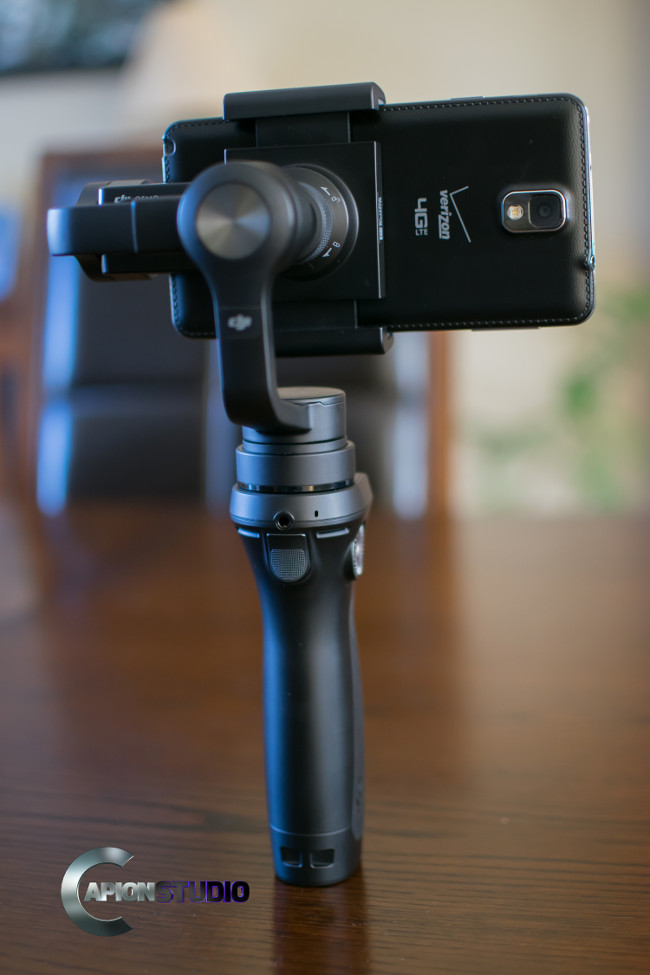
Summing up, the DJI Osmo Mobile is incredible for the money. Sure, it has some pitfalls, particulary with app performance and compatibility, but it does make good on its promises of smooth footage with a greater level of control. My honest review of this item is that it will only get better with time. As cell phones become better with new technology, the content will become easier to mix and match with professional footage.
The dream is to have a small camera that gives you buttery smooth footage that can fit in your pocket and the DJI Osmo delivers. Buy or rent this one today – seriously, it's worth it!
Tags: Production



Comments